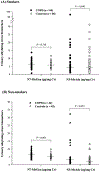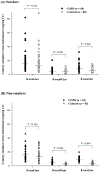Alkylating and oxidative stresses in smoking and non-smoking patients with COPD: Implications for lung carcinogenesis
- PMID: 33418114
- PMCID: PMC7897309
- DOI: 10.1016/j.freeradbiomed.2020.12.442
Alkylating and oxidative stresses in smoking and non-smoking patients with COPD: Implications for lung carcinogenesis
Abstract
Chronic obstructive pulmonary disease (COPD) is a disease characterized by chronic inflammation and irreversible airway obstruction. Cigarette smoking is the predominant risk factor for developing COPD. It is well-known that the COPD is also strongly associated with an increased risk of developing lung cancer. Cigarette smoke contains elevated concentrations of oxidants and various carcinogens (e.g., tobacco-derived nitrosamines) that can cause oxidative and alkylating stresses, which can also arise from inflammation. However, it is surprising that, except for oxidative stress, little information is available on the burden of alkylating stress and the detoxification efficiency of tobacco-derived carcinogens in COPD patients. In this study, we used LC-MS/MS to measure the archetypical tobacco-specific carcinogenic 4-(methylnitrosamino)-1-(3-pyridyl)-1-butanone (NNK), its major metabolite, 4-(methylnitrosamino)-1-(3-pyridyl)-1-butanol (NNAL), three biomarkers of oxidative stress (8-oxo-7,8-dihydroguanine, 8-oxoGua; 8-oxo-7,8-dihydro-2'-deoxyguanosine, 8-oxodGuo; 8-oxo-7,8-dihydroguanosine, 8-oxoGuo) and two biomarkers of alkylating stress (N7-methylguanine, N7-MeGua and N3-methyladenine, N3-MeAde), in the urine of smoking and non-smoking COPD patients and healthy controls. Our results showed that not only was oxidative stress significantly elevated in the COPD patients compared to the controls, but also alkylating stress. Significantly, levels of alkylating stress (i.e., N7-MeGua) were highly correlated with the COPD severity and not affected by age and smoking status. Furthermore, COPD smokers had significantly higher ratios of free NNAL to the total NNAL than control smokers, implying a lower detoxification efficiency of NNK in COPD smokers. This ratio was even higher in COPD smokers with stages 3-4 than in COPD smokers with stages 1-2. Taken together, our results demonstrated that the detoxification efficiency of tobacco-derived carcinogens (e.g., NNK) was associated with the pathogenesis and possibly the progression of COPD. In addition to oxidative stress, alkylating stress derived from chronic inflammation appears to be also dominant in COPD patients.
Keywords: COPD; Inflammation; Methylated DNA damage; NNAL; NNK; Oxidative DNA/RNA damage.
Copyright © 2020 Elsevier Inc. All rights reserved.
Conflict of interest statement
Conflict of interest
The authors declare that they have no conflict of interest.
Figures




Similar articles
-
Direct analysis of tobacco-specific nitrosamine NNK and its metabolite NNAL in human urine by LC-MS/MS: evidence of linkage to methylated DNA lesions.Arch Toxicol. 2014 Feb;88(2):291-9. doi: 10.1007/s00204-013-1137-y. Epub 2013 Sep 22. Arch Toxicol. 2014. PMID: 24057573
-
Children are particularly vulnerable to environmental tobacco smoke exposure: Evidence from biomarkers of tobacco-specific nitrosamines, and oxidative stress.Environ Int. 2018 Nov;120:238-245. doi: 10.1016/j.envint.2018.08.006. Epub 2018 Aug 10. Environ Int. 2018. PMID: 30103123
-
Analysis of human urine for pyridine-N-oxide metabolites of 4-(methylnitrosamino)-1-(3-pyridyl)-1-butanone, a tobacco-specific lung carcinogen.Cancer Epidemiol Biomarkers Prev. 1997 Feb;6(2):113-20. Cancer Epidemiol Biomarkers Prev. 1997. PMID: 9037562
-
Tobacco-specific N-nitrosamines and Areca-derived N-nitrosamines: chemistry, biochemistry, carcinogenicity, and relevance to humans.J Toxicol Environ Health. 1994 Jan;41(1):1-52. doi: 10.1080/15287399409531825. J Toxicol Environ Health. 1994. PMID: 8277523 Review.
-
DNA adduct formation from tobacco-specific N-nitrosamines.Mutat Res. 1999 Mar 8;424(1-2):127-42. doi: 10.1016/s0027-5107(99)00014-7. Mutat Res. 1999. PMID: 10064856 Review.
Cited by
-
Pathological Mechanism and Targeted Drugs of COPD.Int J Chron Obstruct Pulmon Dis. 2022 Jul 12;17:1565-1575. doi: 10.2147/COPD.S366126. eCollection 2022. Int J Chron Obstruct Pulmon Dis. 2022. PMID: 35855746 Free PMC article. Review.
-
Nutritional Support of Chronic Obstructive Pulmonary Disease.Nutrients. 2025 Mar 26;17(7):1149. doi: 10.3390/nu17071149. Nutrients. 2025. PMID: 40218907 Free PMC article. Review.
-
Role of Genetic Polymorphisms in IL12Rβ2 in Chronic Obstructive Pulmonary Disease.Int J Chron Obstruct Pulmon Dis. 2022 Jul 27;17:1671-1683. doi: 10.2147/COPD.S366844. eCollection 2022. Int J Chron Obstruct Pulmon Dis. 2022. PMID: 35923356 Free PMC article.
-
CircRNA_0026344 via miR-21 is involved in cigarette smoke-induced autophagy and apoptosis of alveolar epithelial cells in emphysema.Cell Biol Toxicol. 2023 Jun;39(3):929-944. doi: 10.1007/s10565-021-09654-5. Epub 2021 Sep 15. Cell Biol Toxicol. 2023. PMID: 34524572
-
Effects of Ipratropium Bromide Combined with Traditional Chinese Medicine Intervention on the Pulmonary Function and Psychological Status of Patients with Chronic Obstructive Pulmonary Disease.Evid Based Complement Alternat Med. 2023 Feb 7;2023:6483785. doi: 10.1155/2023/6483785. eCollection 2023. Evid Based Complement Alternat Med. 2023. PMID: 36798728 Free PMC article.
References
-
- Barnes PJ, Burney PG, Silverman EK, Celli BR, Vestbo J, Wedzicha JA, Wouters EF, Chronic obstructive pulmonary disease, Nat. Rev. Dis. Primers 1 (2015) 15076. - PubMed
-
- Salvi S, Tobacco smoking and environmental risk factors for chronic obstructive pulmonary disease, Clin. Chest Med 35 (2014) 17–27. - PubMed
-
- Pryor WA, Stone K, Oxidants in cigarette smoke. Radicals, hydrogen peroxide, peroxynitrate, and peroxynitrite, Ann. N. Y Acad. Sci 686 (1993) 12–27. - PubMed
Publication types
MeSH terms
Substances
Grants and funding
LinkOut - more resources
Full Text Sources
Other Literature Sources
Medical

